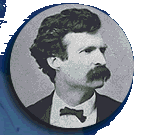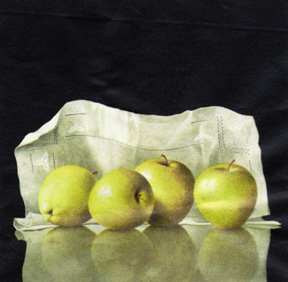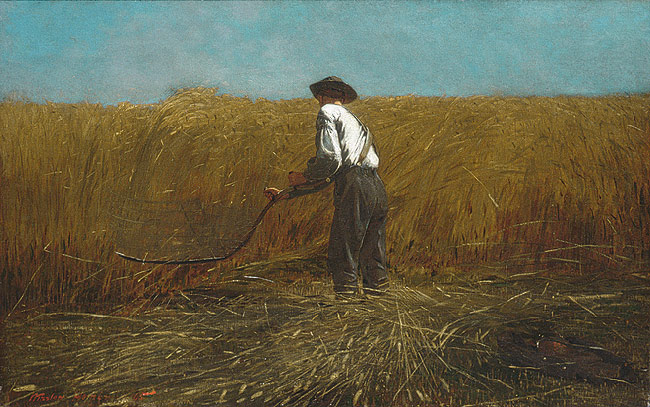
|
Anxiety of Influence |
Click here for study and time management tips listed at bottom of page
Click on an author in the table to find studyguides and writing topics
| Mark Twain | Henry James | Susan Glaspell |
| Sarah Orne Jewett | Willa Cather | Kate Chopin |
Realism (click here to go to the art gallery of realism): One way to begin to understand Realism is to think of the opposite mindset of a Romantic. Where as the author of a romantic work will emphasize imagination and metaphor, the realist tries to portray things as they really are. No longer do we have a king or the ruling class as protagonist; realist authors strive to present everyday people in extraordinary circumstances to show that high tragedy can exist in any region of the United States. Watch how Twain invokes Shakespeare along the muddy Mississippi. What other romantic elements can be stretched inside out to form an element of realism?
Some basic elements of Realism, which was in some ways a reaction to Romanticism;
An offshoot of realism is Regionalism. When we analyze Twain's
work with the critical lens of regionalism, we also summon Harold Bloom's Anxiety
of Influence within Twain's region. We will explain this theory in class. For
Twain's sake, we will analyze how he used Satire in/of his region. In addition,
Willa Cather’s My Antonia explores Regionalism
as does Twain’s Masterpiece, Huckleberry Finn. Cather’s
book begins with the inscription Optima dies...Prima fugit. (The best
days are the first to flee.) In the middle of his childhood (Absent parents?
You bet!), the narrator/protagonist of My Antonia reflects on his native
region, Nebraska, and summons more lines from Virgil’s Georgics:
Primus ego in patriam mecum...deducam Musas (For I shall be the first,
if I live, to bring the Muse into my country land [region]). Many Cather readers
believe that she, as an author, succeeds in this literary venture. Does Twain?
How does Twain bring the Muse into his region? What other author(s) is/are haunting
his text?
NB: Homer describes a bunch of Rose-fingered dawns. Reread chapter 19 and reflect.
In class be sure to understand how we use this famous literary theory, Harold
Bloom's The Anxiety of Influence. Notice how Twain deals with this
"anxiety of influence" by using satire and humor.
Topics for The Adventures
of Huckleberry Finn
Racism: explore 19th century racism (NB: Pap's loud racist remarks will be similar to Tom Buchanan's in The Great Gatsby) in the text and ask the larger question, how did this novel--particularly the depiction of Jim's humanity in the middle of the novel--break down stereotypes of slavery? Towards the end of the novel, we will watch Huck and Tom trying to free a free man on Uncle Silias (Did you catch the initials of Uncle Silias? US?) Uncle Silias' farm. How does this relate to the political and historical landscape of late nineteenth century America? How does it relate to Twain's own trip down the Mississippi river after slavery which made him wonder how we can free a free man. In this case, sharecropping had replaced slavery as the institution; what happened to voting rights in the 19th century south)?
Picaresque Narrative: “`Picaro’ is Spanish for `rogue’ and the subject of a typical story is the escapades of an insouciant rascal who lives by his wits, and shows little if any alteration of character through the long succession of his adventures; picaresque fiction is realistic in manner, episodic in structure (as opposed to the sustained development of a single Plot), and usually satiric in aim” (Abrams 119).
Satire: A humorist at heart, Twain satirizes a number of subjects in this novel: slavery, southern culture, a misplaced American value for money, the confidence man, American and European Romanticism, his own literary heroes such as Shakespeare--no one is safe!
Psychoanalytical Topics:
One approach for this fun topic: From the moment the reader discovers the Notice that appears in The Adventures of Huckleberry Finn’s preface (the pretext), one subtly understands that powerful material lies ahead in the upcoming text. On the one hand, Twain infuses humor by suggesting that “persons attempting to find a plot” in the book will be shot. On the other hand, Twain’s humor covers and masks profound issues. With this second perspective in mind, write an essay discussing the significance of three related scenes, characters, objects, or symbols. For time’s sake limit your well developed discussion to three things.
With this in mind, brainstorm your topic by listing things related to the father and son plot. Then reflect on your whole list before you try to sculpt a concentration or thesis.
Another approach for this fun topic: Thoroughly discuss one literary pattern from the novel. Throughout the course of the novel--and I choose that word course carefully--Samuel Clemens’--rather, Mark Twain develops in The Adventures of Huckleberry Finn several motifs. In other words, several literary patterns emerge as the reader travels through Huck’s adventures. The reader discovers: numerous scenes with hogs; the recurring number, forty, continually revolves around certain figures in the novel; the author constantly creates instances of doubling (doppelganger in German); the author shows characters making, marking and covering tracks; the novel contains interesting scenes of metafiction. Chose one pattern and discuss its significance throughout the text.
More ideas to help you start each the violence between Father and Son relationships.
Interdisciplinary Topic/American Studies Topic:
Look up the book and reflect on some ideas presented in the, Machine in the Garden, by Leo Marx. Help yourself to the following inspirational questions that were enthused on the my computer screen after a rereading of this book:
Other authors classified in the Movement of Realism: Sarah Orne Jewett, Willa Cather, Stephen Crane, Kate Chopin.
Writing Suggestions for Huckleberry Finn
Study management tips:
 |
Did you ever create a still life in art class? What bullet points of Realism are dramatized in this still life? What is the value of an artist's representation of life? What is your favorite still life painting? |
 |
This is Winslow Homer's A Veteran in a New Field. What bullet points of Realism are being dramatized on this canvas? The bottom right corner captures a Union uniform jacket. Where are the subjects feet? Why is his back turned to us? |